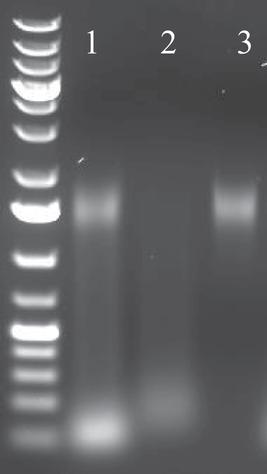下载PDF
{"title":"STARR-seq and UMI-STARR-seq: Assessing Enhancer Activities for Genome-Wide-, High-, and Low-Complexity Candidate Libraries","authors":"Christoph Neumayr, Michaela Pagani, Alexander Stark, Cosmas D. Arnold","doi":"10.1002/cpmb.105","DOIUrl":null,"url":null,"abstract":"<p>The identification of transcriptional enhancers and the quantitative assessment of enhancer activities is essential to understanding how regulatory information for gene expression is encoded in animal and human genomes. Further, it is key to understanding how sequence variants affect enhancer function. STARR-seq enables the direct and quantitative assessment of enhancer activity for millions of candidate sequences of arbitrary length and origin in parallel, allowing the screening of entire genomes and the establishment of genome-wide enhancer activity maps.</p><p>In STARR-seq, the candidate sequences are cloned downstream of the core promoter into a reporter gene's transcription unit (i.e., the 3′ UTR). Candidates that function as active enhancers lead to the transcription of reporter mRNAs that harbor the candidates’ sequences. This direct coupling of enhancer sequence and enhancer activity in <i>cis</i> enables the straightforward and efficient cloning of complex candidate libraries and the assessment of enhancer activities of millions of candidates in parallel by quantifying the reporter mRNAs by deep sequencing. This article describes how to create focused and genome-wide human STARR-seq libraries and how to perform STARR-seq screens in mammalian cells, and also describes a novel STARR-seq variant (UMI-STARR-seq) that allows the accurate counting of reporter mRNAs for STARR-seq libraries of low complexity. © 2019 The Authors.</p><p><b>Basic Protocol 1</b>: STARR-seq plasmid library cloning</p><p><b>Basic Protocol 2</b>: Mammalian STARR-seq screening protocol</p><p><b>Alternate Protocol</b>: UMI-STARR-seq screening protocol—unique molecular identifier integration</p><p><b>Support Protocol</b>: Transfection of human cells using the MaxCyte STX scalable transfection system</p>","PeriodicalId":10734,"journal":{"name":"Current Protocols in Molecular Biology","volume":"128 1","pages":""},"PeriodicalIF":0.0000,"publicationDate":"2019-09-09","publicationTypes":"Journal Article","fieldsOfStudy":null,"isOpenAccess":false,"openAccessPdf":"https://sci-hub-pdf.com/10.1002/cpmb.105","citationCount":"32","resultStr":null,"platform":"Semanticscholar","paperid":null,"PeriodicalName":"Current Protocols in Molecular Biology","FirstCategoryId":"1085","ListUrlMain":"https://onlinelibrary.wiley.com/doi/10.1002/cpmb.105","RegionNum":0,"RegionCategory":null,"ArticlePicture":[],"TitleCN":null,"AbstractTextCN":null,"PMCID":null,"EPubDate":"","PubModel":"","JCR":"Q2","JCRName":"Biochemistry, Genetics and Molecular Biology","Score":null,"Total":0}
引用次数: 32
引用
批量引用
Abstract
The identification of transcriptional enhancers and the quantitative assessment of enhancer activities is essential to understanding how regulatory information for gene expression is encoded in animal and human genomes. Further, it is key to understanding how sequence variants affect enhancer function. STARR-seq enables the direct and quantitative assessment of enhancer activity for millions of candidate sequences of arbitrary length and origin in parallel, allowing the screening of entire genomes and the establishment of genome-wide enhancer activity maps.
In STARR-seq, the candidate sequences are cloned downstream of the core promoter into a reporter gene's transcription unit (i.e., the 3′ UTR). Candidates that function as active enhancers lead to the transcription of reporter mRNAs that harbor the candidates’ sequences. This direct coupling of enhancer sequence and enhancer activity in cis enables the straightforward and efficient cloning of complex candidate libraries and the assessment of enhancer activities of millions of candidates in parallel by quantifying the reporter mRNAs by deep sequencing. This article describes how to create focused and genome-wide human STARR-seq libraries and how to perform STARR-seq screens in mammalian cells, and also describes a novel STARR-seq variant (UMI-STARR-seq) that allows the accurate counting of reporter mRNAs for STARR-seq libraries of low complexity. © 2019 The Authors.
Basic Protocol 1 : STARR-seq plasmid library cloning
Basic Protocol 2 : Mammalian STARR-seq screening protocol
Alternate Protocol : UMI-STARR-seq screening protocol—unique molecular identifier integration
Support Protocol : Transfection of human cells using the MaxCyte STX scalable transfection system
STARR-seq和uni -STARR-seq:评估全基因组、高复杂性和低复杂性候选文库的增强子活性
转录增强子的鉴定和增强子活性的定量评估对于理解基因表达的调控信息是如何在动物和人类基因组中编码的至关重要。此外,了解序列变异如何影响增强子功能是关键。STARR-seq能够直接定量评估数百万个任意长度和来源的候选序列的增强子活性,从而筛选整个基因组并建立全基因组增强子活性图谱。在STARR-seq中,候选序列被克隆到核心启动子的下游,进入报告基因的转录单元(即3 ' UTR)。作为活性增强子的候选基因导致含有候选基因序列的报告mrna的转录。这种cis中增强子序列和增强子活性的直接耦合使得复杂候选文库的克隆和通过深度测序定量报告mrna并行评估数百万候选增强子活性成为可能。本文描述了如何创建集中的和全基因组的人类STARR-seq文库,以及如何在哺乳动物细胞中执行STARR-seq筛选,还描述了一种新的STARR-seq变体(UMI-STARR-seq),它允许对低复杂性的STARR-seq文库的报告mrna进行准确计数。©2019作者。基本协议1:STARR-seq质粒文库克隆基本协议2:哺乳动物STARR-seq筛选协议备用协议:uni -STARR-seq筛选协议-唯一分子标识符集成支持协议:使用MaxCyte STX可扩展转染系统转染人类细胞
本文章由计算机程序翻译,如有差异,请以英文原文为准。



